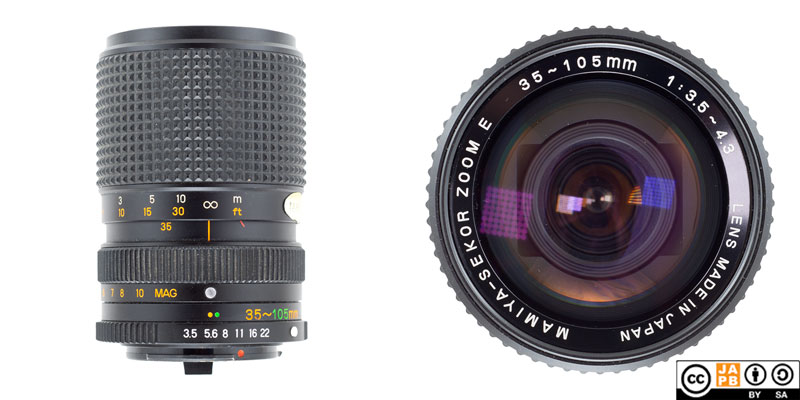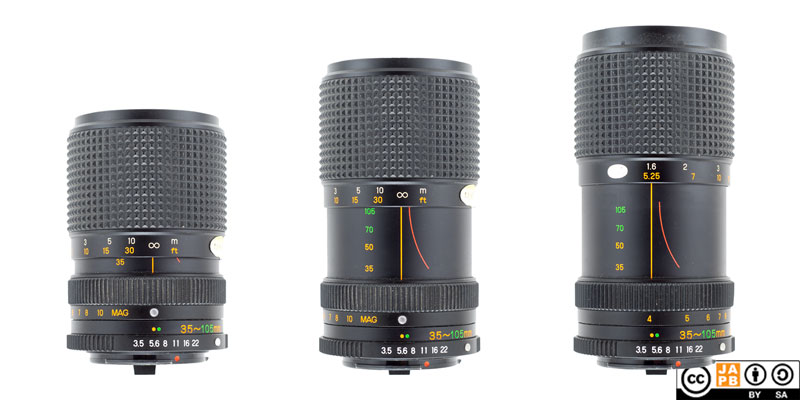Pekka Buttler, 07/2024

Specifications
The table below summarizes the lens’ key specifications (measurements based on pictured sample):
| Brand: | Mamiya-Sekor | Lens name | Zoom E 35~105mm 1:3.5~4.3 |
| Focal length(s)1 | 35–105 mm | Angle-of-view2 | 63,4°–23,3° |
| Maximum Aperture | f/3.5–4.3 | In Production | 1980-1984 |
| Lens mount | Mamiya Z/E | Subfamily (if applicable) | –– |
| Length3 | 90,2 mm | Diameter4 | 62,9 mm |
| Filter ring diameter | 55 mm | Weight | 447 grams |
| Lens element count | 15 | Lens group count | 13 |
| Aperture blades (S/R/C)5 | 6 S | Focus throw | 110 ° |
| Minimum focusing distance | 1,5 m (0,28m) | Maximum magnification | 1:12.2 (1:4,3) |
| Has manual aperture ring | NO | Has Manual focus ring | YES |
| Aperture mechanism type | electronic/mechanic 6 | Aperture click stops 7 | 3.5••5.6•8•11•16•22 |
Further notes:
• In 1980 Mamiya introduced the Z line of cameras and altogether 16 lenses.
• 10 of those lenses were regular primes in the range of 28 to 300 mm, one short macro lens and altogether 5 zooms.
• Of those zooms, one can be characterised as a wide-angle zoom (28–50 mm), two can be described as standard zooms (35–70 and 35–105), and two more were typical tele zooms (70–150 and 80–200).
• Judging by their element counts, two of those zooms were constructed using a more elaborate/ambitious design. One of these was the 80–200/3.8 (14 elements in 10 groups) and the other was the 35–105/3.5–4.3 (15 elements in 13 groups) (this lens).

Zoomed to 35 mm; focused at infinity;
Zoomed to 105 mm; focused at infinity;
Zoomed to 105 mm; focused at MFD, Macro mode fully deployed.
• This lens is a relatively compact, reasonably bright standard zoom.
• The lens is a one-ring zoom, meaning that you adjust focal length by pushing or pulling on a ring and that you rotate to adjust focus.
• To zoom in (towards a narrower field of view), you push the ring forward. When zooming in, the lens lengthens by ca 2,5 centimetres.
• When rotating the focusing ring from infinity towards minimum focusing distance, the lens becomes a few millimetres longer. The filter threads rotate when focusing.
• The lens is not parfocal – neither at infinity nor MFD.
• It has a relatively short focus throw and a not-too-attractive minimum focal length. On the other hand, the lens has a macro mode that can be engaged at all focal lengths.
• As a quirk that was typical for the Mamiya Z system, the lens does have an aperture ring, but that ring has no function on the lens itself (Mamiya Z lenses aperture rings communicated the chosen aperture to the camera, which in turn did the closing down). This has implications on adaptability (read more below).
Versions
There was only ever one version of the Mamiya-Sekor E 35-105 mm f/3.5–4.3.
History of Mamiya Z/E lenses
Please see the JAPB article on all (7) Mamiya SLR lens mounts to understand the role of the Mamiya Z/E mount.
Adapting
n.B! The following applies to all Mamiya Z/E mount lenses.
This lens cannot be used natively on any current SLR or dSLRs. To use it in its native environment, you will need a Mamiya Z/E-mount film body – a ZE, ZE-2, ZE-X or ZM. While the Mamiya Z/E system remained in production for only 4 years (and was not a mega-hit), these bodies are relatively easy to find.
While the lens sports electronic contacts, these are not needed to facilitate critical functionality. However, as the aperture ring of Mamiya Z/E lenses is a dummy ring (it does not manipulate the lens’ aperture in any way – it instead communicates the aperture to the camera body, which in turn manipulates the lens’ aperture lever), adjusting aperture is a function that has to be taken care of by the adapter.
Therefore, should you aim to adapt this lens to a mirrorless camera you will need an adapter that facilitates adjusting the lens’ aperture. Luckily, every Mamiya Z/E adapter I’ve seen does offer such a functionality. However, due toMamiya Z/E lenses not being among the most numerously manufactured, special adapters (helicoid adapters, tilt/shift adapter and speed boosters) are currently unavailable.
Using Mamiya Z/E lenses on dSLRs is also possible. However, due to that the, difference in flange focal distances between the Mamiya Z/E lens and the dSLR mount (between +1,5 mm and negative 1 mm) invariably does not allow sufficient space for an adapter that allows aperture modification, these adapters are always adapters with added optics to achieve infinity focus.
Footnotes
- Focal length is (unless stated otherwise) given in absolute terms, and not in Full-frame equivalent. For an understanding of whether the lens is wide/tele, see ‘Angle-of-view’. ↩︎
- Picture angle is given in degrees (based on manufacturers’ specs) and concerns the diagonal picture angle. Rule of thumb:
> 90 ° ==> Ultra-wide-angle
70–90 ° ==> Wide-angle
50–70 ° ==> Moderate wide-angle
40–50 ° ==> ‘Standard’ or ‘normal’ lens
20–40 ° ==> Short tele lens
10-20 ° ==> Tele lens
5-10 ° ==> Long tele lens
< 5 ° ==> Ultra-tele lens ↩︎ - Length is given from the mount flange to the front of lens at infinity. ↩︎
- Diameter excludes protrusions such as rabbit ears or stop-down levers. ↩︎
- S=straight; R=rounded; C=(almost)circular at all apertures. ↩︎
- The lens communicates the selected aperture electronically, but the lens is closed down mechanically. ↩︎
- Numbers equal aperture values on aperture ring; • intermediate click; – no intermediate click. ↩︎